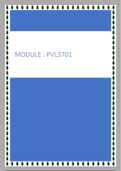Exam (elaborations)
PVL3701 Exam Study Revision Pack
- Institution
- University Of South Africa (Unisa)
These are Exam questions and solutions as well as detailed study notes including those that were found in assignments, study guides and practice questions. When you work through these you will gain an excellent understanding of concepts, theories, techniques and methods which will allow you to answ...
[Show more]



